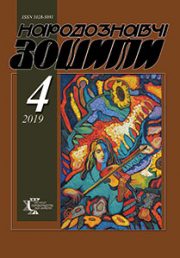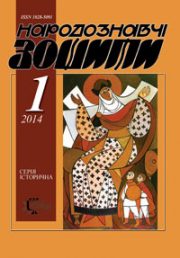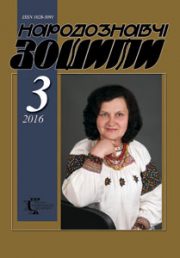The Ethnology Notebooks. 2023. № 4 (172), 869—876
UDK [069.5:061.2(477)НТШ]:655.3.066.32″1912/1914
DOI https://doi.org/10.15407/nz2023.04.869
HERII Oksana
- ORCID ID: https://orcid.org/0000-0002-8383-227X
- Ph. D in Art Studies,
- Senior Researcher at the Art Studies Department,
- The Institute of Ethnology of the National
- Academy of Sciences of Ukraine,
- 15, Svobody Avenue, 79000, Lviv, Ukraine,
- Contacts: e-mail: oheriy@ukr.net
Abstract. Introduction. The article discusses one of the lesser-explored collections of the Shevchenko Scientific Society Museum — a collection of illustrated postcards. After the dissolution of the museum in 1940, the collection was scattered across various institutions in Ukraine. However, a large portion of it, about 10000 items, ended up in the library of the Institute of Ethnology of the National Academy of Sciences of Ukraine. The aim is to examine six postcards from the Shevchenko Scientific Society Museum collection, published by the «All-Ukrainian Publishing House», trace their history of creation, the people involved, and characterize their impact on the target audience. These postcards were produced in 1913, thus the period from the emergence of the first illustrated holiday card in Galicia (1904) to the beginning of World War I will serve as the timeframe for this article.
Problem statement. To better understand the historical and cultural context of the appearance of the Easter greeting postcards from the «All-Ukrainian Publishing House» in the village of Kryvopole (now Kryvopillia in the Verkhovyna district of the Ivano-Frankivsk region), a brief overview of the development of Ukrainian greeting postcards, their themes, and aesthetic design principles is provided. The activities of photographer Semen Burko, publishers Bohdan Zaklynskyi and Franz Andrusevych, who were involved in the publication of the series of illustrated postcards by the «All-Ukrainian Publishing House» (1912—1914), are examined. The article’s author focuses on the analysis of two postcards (Part 5 and Part 6) with photographic images of festive Easter still lifes. The bold and intriguing combination of objects in the composition, ornamented with traditional folk motifs (pysanky) and motifs that represent a new, urban culture-inspired interpretation of traditional art (ceramics from Ivan Levynskyi’s factory), is showcased.
The result of the research is the demonstration, through specific visual examples, of the important educational function of Ukrainian illustrated postcards, as well as an emphasis on the encoded contemporary responses of artists to the challenges of their time.
The methodological basis of the research is the structural-typological method and the method of art analysis.
Keywords: Shevchenko Scientific Society, postcard, traditional ornament, ceramics from Ivan Levynskyi’s factory.
Received 20.07.2023
REFERENCES
- Kushnir, V. (2021). Museum of the scientific society named after Shevchenko (1892—1940). Lviv [in Ukrainian].
- Gorban, I. (2012). Museum of Ethnography and Art Craft. In: Encyclopedia of Lviv (Vol. 4, pp. 773—787). Lviv: Litopys [in Ukrainian].
- Polyanskyi, S. & Polyanskyi, Yu. (1920). State of the museum of the Shevchenko Scientific Society in 1914—1920. Lviv [in Ukrainian].
- Sapeliak, O. (2000). Ethnographic studies in the Shevchenko Scientific Society (1898—1939). Lviv [in Ukrainian].
- Kupchynska, L. (2021). Collection of postcards of the Museum of the Shevchenko Scientific Society in the funds of the V. Stefanyk LNSL of Ukraine. Lviv National Scientific Library of Ukraine named after V. Stefanyk: history, sources, figures (Pp. 150—154) [in Ukrainian].
- Zapolovsky, V., Osadchuk, S., & Snigur, I. (Eds). (2014). The postcard as a means of propaganda during the war of 1914—1918. In: Osadchuk, S., Snigur, I. The World War in postcards of 1914—1918 (Pp. 15—24). Chernivtsi: Zelena Bukovyna [in Ukrainian].
- Shcheglyuk, M. (2009). History of Ukrainian correspondence (Vol. 1). Lviv: Spolom [in Ukrainian].
- (1928, april 7). Dilo (P. 4) [in Ukrainian].
- (1902, november 13). Dilo (P. 3) [in Ukrainian].
- (1904, march 17). Dilo (P. 3) [in Ukrainian].
- Pshenycznyj, E. (2009). The warm glow of a holiday card. In: Korpanyuk, P., Polegenkyi, S., Ukrainian holiday card: Album (Pp. 10—15). Kyiv: Art Center «Barvy» [in Ukrainian].
- Dombrovska, E. & Kovaliv, Yu. (2015). Andrusevich Franz. Shevchenko Scientific Society: encyclopedia. Retrieved from: https://encyclopedia.com.ua/entry-79 [in Ukrainian].
- Kovaliv, Yu. (2015). Burko Semen. Shevchenko Scientific Society: encyclopedia. Retrieved from: https://encyclopedia.com.ua/entry-466 [in Ukrainian].
- Manko, V. (2005). Ukrainian folk Easter egg. Lviv: Svichado [in Ukrainian].
- Herii, O. (2020). Ornamentation of ceramic products. The ceramic code of Ivan Levinsky in the aesthetic dimension of a Ukrainian of the late 19th and early 20th centuries (Pp. 46—65). Kharkiv; Lviv [in Ukrainian].







